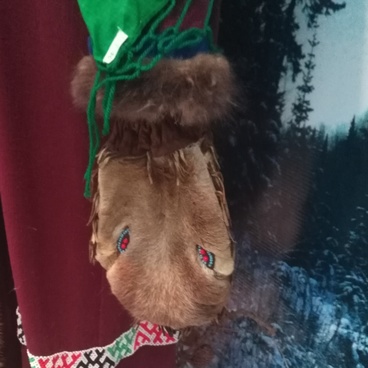A mortar is an ancient instrument for grinding or pounding. In the last century it was hard to find a peasant house without a mortar. This utensil was made from part of hardwood trunk. Mortar shapes depended on the skill and creativity of the craftsman. Most often it had a round foundation protruding a little versus the walls — this made the mortar stable.
The heavier the mortar, the easier it was to perform laborious operations of processing agricultural stock. Mortars were used to remove hulls form wheat, rye and oat grains, to pound flax stems, ready canvas and yarn to soften it. Woolen cloth craftsmen battered cloth in mortars and leather dressers — oak and willow bark for leather tanning.
Double mortars chiselled on both ends were as widespread as single ones. One part was used for grains and the other shallower one for tobacco. Men planted tobacco, dried it, cut in special backets and then ground it.
A pestle for the mortar was carved from a whole wood piece — it was used to push the material. A pestle could be up to a meter long with one end bound with iron. The tool had a connector in the middle so that it could be held conveniently and the hand would not slide.
Besides large mortars peasants used small ones, mostly made of pig iron to pestle salt, grain and other products. These are still used in many homes even in modern kitchens.
People believed that a mortar and pestle symbolized the union of male and female nature, so they were used in wedding rites. Famous Russian ethnographer Dmitry Zelenin wrote that before entering a young girl’s house a matchmaker would rotate a mortar three times around herself, so that the matchmaking would be successful. In the same way, a bride was taken around the altar three times in church.
Mortars were sometimes used to test the character of the young daughter-in-law: her relatives would pour water in the mortar and gave it to her to tread until all liquid spilled out. This was the origin of the popular saying “to tread water” — do useless work.
The heavier the mortar, the easier it was to perform laborious operations of processing agricultural stock. Mortars were used to remove hulls form wheat, rye and oat grains, to pound flax stems, ready canvas and yarn to soften it. Woolen cloth craftsmen battered cloth in mortars and leather dressers — oak and willow bark for leather tanning.
Double mortars chiselled on both ends were as widespread as single ones. One part was used for grains and the other shallower one for tobacco. Men planted tobacco, dried it, cut in special backets and then ground it.
A pestle for the mortar was carved from a whole wood piece — it was used to push the material. A pestle could be up to a meter long with one end bound with iron. The tool had a connector in the middle so that it could be held conveniently and the hand would not slide.
Besides large mortars peasants used small ones, mostly made of pig iron to pestle salt, grain and other products. These are still used in many homes even in modern kitchens.
People believed that a mortar and pestle symbolized the union of male and female nature, so they were used in wedding rites. Famous Russian ethnographer Dmitry Zelenin wrote that before entering a young girl’s house a matchmaker would rotate a mortar three times around herself, so that the matchmaking would be successful. In the same way, a bride was taken around the altar three times in church.
Mortars were sometimes used to test the character of the young daughter-in-law: her relatives would pour water in the mortar and gave it to her to tread until all liquid spilled out. This was the origin of the popular saying “to tread water” — do useless work.



